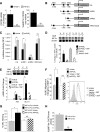Pharmacologic increase in HIF1α enhances hematopoietic stem and progenitor homing and engraftment
- PMID: 24167196
- PMCID: PMC3888286
- DOI: 10.1182/blood-2013-07-516336
Pharmacologic increase in HIF1α enhances hematopoietic stem and progenitor homing and engraftment
Abstract
Hematopoietic stem cell (HSC) transplantation is a lifesaving therapy for a number of immunologic disorders. For effective transplant, HSCs must traffic from the peripheral blood to supportive bone marrow niches. We previously showed that HSC trafficking can be enhanced by ex vivo treatment of hematopoietic grafts with 16-16 dimethyl prostaglandin E2 (dmPGE2). While exploring regulatory molecules involved in dmPGE2 enhancement, we found that transiently increasing the transcription factor hypoxia-inducible factor 1-α (HIF1α) is required for dmPGE2-enhanced CXCR4 upregulation and enhanced migration and homing of stem and progenitor cells and that pharmacologic manipulation of HIF1α is also capable of enhancing homing and engraftment. We also now identify the specific hypoxia response element required for CXCR4 upregulation. These data define a precise mechanism through which ex vivo pulse treatment with dmPGE2 enhances the function of hematopoietic stem and progenitor cells; these data also define a role for hypoxia and HIF1α in enhancement of hematopoietic transplantation.
Figures


Comment in
-
Opening the door for HIF1α tuning.Blood. 2014 Jan 9;123(2):151-2. doi: 10.1182/blood-2013-11-536995. Blood. 2014. PMID: 24408203 No abstract available.
References
-
- Verma DS, Spitzer G, Zander AR, McCredie KB, Dicke KA. Prostaglandin E1-mediated augmentation of human granulocyte-macrophage progenitor cell growth in vitro. Leuk Res. 1981;5(1):65–71. - PubMed
Publication types
MeSH terms
Substances
Grants and funding
LinkOut - more resources
Full Text Sources
Other Literature Sources
Medical
Molecular Biology Databases

